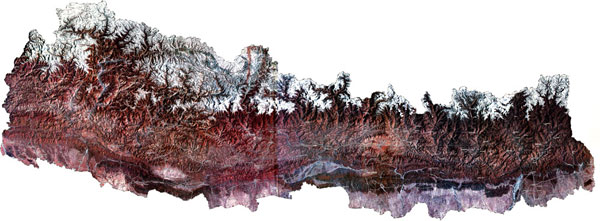
A composite portrait of Nepal made by joining ten satellite pictures taken during cloudless days between 2-23 March, 1977. This famous Landsat image was prepared by the Nepal Remote Sensing Centre with help from the German Ministry of Economic Cooperation and the World Bank. Satellite mapping techniques have advanced since then, but this image still stands out for its clarity and remains a valuable tool to measure landcover trends. Comparisons with satellite imagery taken 25 years later show that although much of the hardwood forests of the eastern and middle tarai that we see in this picture have been cleared, the forest cover in Nepal's midhills has made a comeback due to successes of our community forestry programme.

Bhaktapur
The Arniko Highway south of Bhaktapur skirts terraced fields of wheat in this picture taken by a satellite flying 250 km above the earth at about noon in Feburary 1987. The poplar trees cast long shadow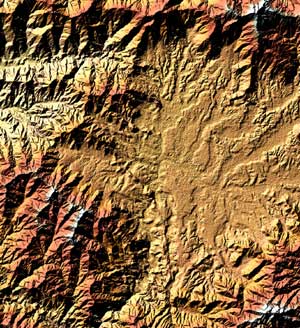
Kathmandu
Kathmandu Valley's topography is dominated by the former lake-bed and the channels cut by the Bagmati and its tributaries through the alluvium. The lake was formed by the tectonic uplift of the Mahabharat Range at the southern rim of the Valley, and the Bagmati was ultimately able to cut its way through the limestone hills at Chobhar, draining the lake.
These two pictures are an X-SAR digital elevation model (left) and a radar amplitude image (below).


Mt Everest
This spectacular picture looks straight down at Mount Everest. The highest mountain in the world casts the longest shadow. The Rongbuk glacier snakes off to the right into the Tibetan plateau, the narrow cup of the Western Cwm starts at the head of the Khumbu Glacier. The top of Mt Everest is made up of yellowish limestone, meaning that the rocks on the highest point on earth were formed at the bottom of the ocean.
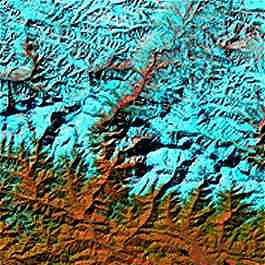
The Kali Gandaki
The world's deepest gorge from the Landsat Thematic Mapper taken in January 1989. Snow and ice appear as blue while vegetation is green. Rocks are red and clouds white. Most major Himalayan rivers are older than the mountains. The river basins follow the location of the original pre-Himalayan rivers that drained the Tibetan marginal mountains and flowed into the Tethys Sea 75 million years ago. As the mountains rose, the rivers were able to cut through them. This is why the Kali Gandaki, Arun, Bhote Kosi, Buri Gandaki and the Karnali all have their headwaters beyond the main chain of the Himalaya and have cut stupendous gorges through the rising rock.
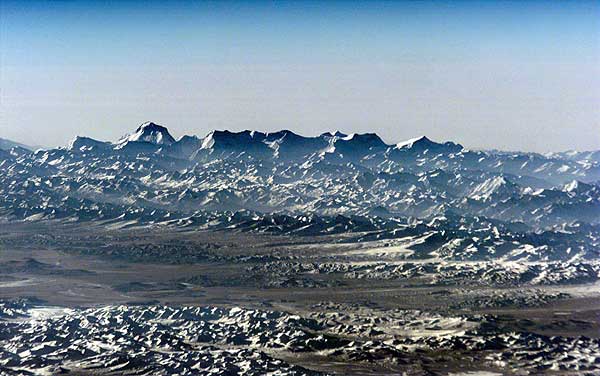
Dhaulagiri
This is not a picture taken from a jet at 35,000 ft, but a slanting view of the Dhaulagiri range taken by the Expedition 1 crew from the International Space Station using a high-magnification lens. The photograph was taken out of the window of the Space Station from an orbital altitude of 200 nautical miles (370 km). The view is southeast-ward across the southern Tibetan Plateau and Dolpo towards the world's seventh highest mountain, Dhaulagiri, which dominates the horizon. The uplift of the Himalaya continues today at a rate of several millimeters per year, pushed by the continuing collision of the Indian tectonic plate with the Eurasian one that began about 70 million years ago.

Himalayan smoke
After three years of Himalayan drought, there was a rash of forest fires in the Himalayan midhills from Kashmir to Himachal Pradesh in the spring of 2000. Smoke from the fires, carried by westerly winds right across Nepal, can be clearly seen in this SeaWiFS satellite image. Also seen clearly are the crystal blue lakes dotting the Tibetan Plateau.
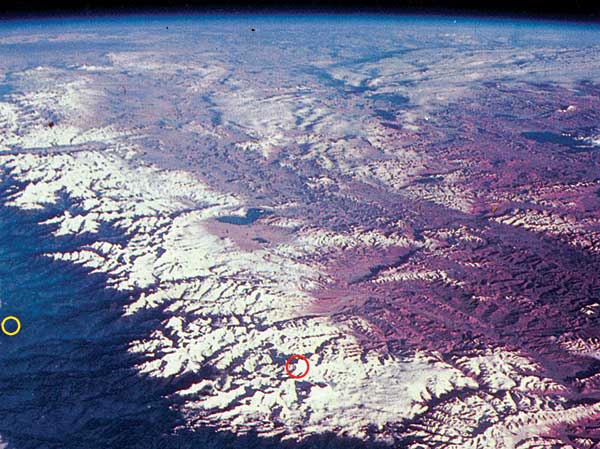
The Himalaya
One of the most prominent physical features visible on the surface of the earth from space are the Himalaya. This unique photograph was taken from a space shuttle in 1988 and shows the ochre expanse of the Tibetan plateau on the right, the snow-covered Himalaya stretching diagonally across, and the dark green of the Mahabharat Range on the left. The red circle shows location of Mt Everest and the yellow circle shows Kathmandu.


